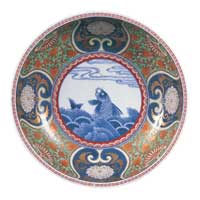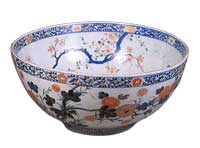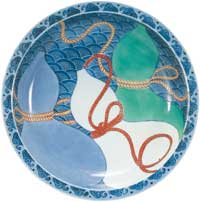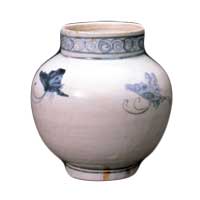The Toguri Museum of Art:
Exhibition Schedule for April 2018 – March 2019
◇April 4 – June 21, 2018
Kinrande: Imari Ware that Captivated the World
 The years 1688–1704 are known in Japan as the Genroku era, a time of flourishing culture supported largely by the growing class of wealthy and powerful merchants. They favored luxury and increasingly sought out dishes with lavish overglaze decoration. Also at this time, as if perfectly timed to meet such demand, the Kinrande (“gold brocade”) style developed in Imari ware. Dishes in this style were richly decorated with colorful overglaze and gold decoration and were very popular among those who could afford them. In time, this style came to typify Imari ware with overglaze decoration. Dishes and jars in the Kinrande style were also produced for export and were highly prized in Europe, where the nobility used them at their tables and in decorating the interiors of their castles.
The years 1688–1704 are known in Japan as the Genroku era, a time of flourishing culture supported largely by the growing class of wealthy and powerful merchants. They favored luxury and increasingly sought out dishes with lavish overglaze decoration. Also at this time, as if perfectly timed to meet such demand, the Kinrande (“gold brocade”) style developed in Imari ware. Dishes in this style were richly decorated with colorful overglaze and gold decoration and were very popular among those who could afford them. In time, this style came to typify Imari ware with overglaze decoration. Dishes and jars in the Kinrande style were also produced for export and were highly prized in Europe, where the nobility used them at their tables and in decorating the interiors of their castles. Later, in the Meiji period, various handcrafted items that had previously been regarded as tools came to be appreciated as art. Until then, Imari ware had been seen merely as utensils to be used when serving food or drink. But increasing numbers of connoisseurs both overseas and in Japan began to regard Imari ware as works of art to be viewed and admired. And the first pieces to be enjoyed in this way were those in the Kinrande style.
In this exhibition, we invite you to observe this transformation from luxury dishes to works of art as you experience the dazzling splendor of Kinrande, the Imari ware that captivated the world.
◇July 4 – Sept. 22, 2018
Flower and Plant Designs in Imari Ware
 In Japan, ever since ancient times, it has been a custom to enjoy the plants and flowers of the four seasons. For this reason, one often sees plant and flower designs in traditional crafts. Imari ware is no exception, and plant and flower motifs were often incorporated in both shape and added designs. Some motifs were borrowed from China, where they were already established as auspicious symbols. Examples include the “Three Friends of Winter” (pine, bamboo and plum), which symbolize perseverance in the face of adversity; the peony (prosperity and fame), the chrysanthemum (long life) and the gourd (many offspring). Other motifs took on different meanings, becoming uniquely Japanese symbols of good wishes and fortune
In the Edo period, soon after the production of Imari ware began, there was a boom of interest in plants and gardens. Many books and manuals were published about the cultivation of plants and flowers. As can be seen in the existence of famous rankings of chrysanthemums, for example, the culture of flower appreciation spread, and many familiar plants and flowers were incorporated as motifs in Imari ware. In 1828, the first Japanese botanical compendium was published, becoming the foundation for all future plant and flower encyclopedias. Titled “Honzō Zufu (Iconographia Plantarum, or Diagrams and Chronicles of Botany), it was written by Iwasaki Kan’en and richly illustrated with woodblock prints.
Referencing this important botanical work, we have organized this exhibition in encyclopedic fashion, as a compendium of botanical designs seen in Imari ware. Please imagine yourself turning the pages of a beautiful botanical encyclopedia, as you enjoy the approximately 80 fine works on display.
<Bowl, decorated with chrysanthemum and plum design in underglaze blue, overglaze enamels and gold. Imari ware. Edo period. Late 17th-the first half of the 18th century.>
In Japan, ever since ancient times, it has been a custom to enjoy the plants and flowers of the four seasons. For this reason, one often sees plant and flower designs in traditional crafts. Imari ware is no exception, and plant and flower motifs were often incorporated in both shape and added designs. Some motifs were borrowed from China, where they were already established as auspicious symbols. Examples include the “Three Friends of Winter” (pine, bamboo and plum), which symbolize perseverance in the face of adversity; the peony (prosperity and fame), the chrysanthemum (long life) and the gourd (many offspring). Other motifs took on different meanings, becoming uniquely Japanese symbols of good wishes and fortune
In the Edo period, soon after the production of Imari ware began, there was a boom of interest in plants and gardens. Many books and manuals were published about the cultivation of plants and flowers. As can be seen in the existence of famous rankings of chrysanthemums, for example, the culture of flower appreciation spread, and many familiar plants and flowers were incorporated as motifs in Imari ware. In 1828, the first Japanese botanical compendium was published, becoming the foundation for all future plant and flower encyclopedias. Titled “Honzō Zufu (Iconographia Plantarum, or Diagrams and Chronicles of Botany), it was written by Iwasaki Kan’en and richly illustrated with woodblock prints.
Referencing this important botanical work, we have organized this exhibition in encyclopedic fashion, as a compendium of botanical designs seen in Imari ware. Please imagine yourself turning the pages of a beautiful botanical encyclopedia, as you enjoy the approximately 80 fine works on display.
<Bowl, decorated with chrysanthemum and plum design in underglaze blue, overglaze enamels and gold. Imari ware. Edo period. Late 17th-the first half of the 18th century.>
◇October 5 – December 22, 2018
Nabeshima and Ko-Kutani: Lineage of Design
 The Ko-Kutani style in Imari ware developed in the middle of the 17th century, at a time when porcelain-making in Arita was experiencing great advances in both manufacturing and design. These changes gave birth to a dynamic and colorful new style of Imari ware. The tones in the sometsuke underglaze blue were brighter. Smaller, thinner dishes in new shapes could now be made using clay molds. Many new designs, shapes and decorative elements were introduced. But towards the end of the century, the kilns in Arita increasingly turned to exports and designs favored by Europeans. Some of the characteristics of the Ko-Kutani style were taken forward not in Arita, but rather in the kilns in Okawachi, where Nabeshima ware was made. Nabeshima ware was made, under the auspices of the Saga samurai clan, exclusively as gifts of tribute to be presented to the Shogun and other feudal lords and high-ranking officials. Only the best craftsmen, drawn from the kilns in Arita, worked in the official kiln where it was made. In both technical achievement and dignity of design and technical achievement, Nabeshima ware still represents the pinnacle in Japanese porcelain. It is important to understand, however, that many of the shapes and decorative techniques seen in Nabeshima ware were in fact developed in Arita. Had it not been for the revolutions in technology and design that occurred there during the mid-17th century, the very existence of Nabeshima ware would never have been possible. In this exhibition, we present together approximately 80 pieces of Nabeshima ware and Imari ware from the mid-17th century, inviting you to compare two competing expressions of beauty. <Dish, decorated with three gourds design in underglaze blue and overglaze enamels. Nabeshima ware. Edo period. Late 17th-early 18th century.>
The Ko-Kutani style in Imari ware developed in the middle of the 17th century, at a time when porcelain-making in Arita was experiencing great advances in both manufacturing and design. These changes gave birth to a dynamic and colorful new style of Imari ware. The tones in the sometsuke underglaze blue were brighter. Smaller, thinner dishes in new shapes could now be made using clay molds. Many new designs, shapes and decorative elements were introduced. But towards the end of the century, the kilns in Arita increasingly turned to exports and designs favored by Europeans. Some of the characteristics of the Ko-Kutani style were taken forward not in Arita, but rather in the kilns in Okawachi, where Nabeshima ware was made. Nabeshima ware was made, under the auspices of the Saga samurai clan, exclusively as gifts of tribute to be presented to the Shogun and other feudal lords and high-ranking officials. Only the best craftsmen, drawn from the kilns in Arita, worked in the official kiln where it was made. In both technical achievement and dignity of design and technical achievement, Nabeshima ware still represents the pinnacle in Japanese porcelain. It is important to understand, however, that many of the shapes and decorative techniques seen in Nabeshima ware were in fact developed in Arita. Had it not been for the revolutions in technology and design that occurred there during the mid-17th century, the very existence of Nabeshima ware would never have been possible. In this exhibition, we present together approximately 80 pieces of Nabeshima ware and Imari ware from the mid-17th century, inviting you to compare two competing expressions of beauty. <Dish, decorated with three gourds design in underglaze blue and overglaze enamels. Nabeshima ware. Edo period. Late 17th-early 18th century.>
◇Jan. 8 – March 24, 2019
Early Imari: Looking to the Continent
 Imari ware was the first porcelain produced in Japan. According to an important historical record, its history began when Japanese forces, following an invasion of the Korean peninsula (1592-1597), returned with several Korean ceramic artisans. This is recorded in the Hagakure, a collection of reflections by Yamamoto Tsunetomo (1659-1719), who was a retainer to Nabeshima Mitsushige (1632-1700), the lord of the Saga clan that ruled over Arita and the Sarayama area where Imari ware was made. In short, Imari ware was made possible by the introduction of technology from the Korean peninsula.
That said, most of the designs in early Imari ware are Chinese in style. Although the technology was acquired from the Korean peninsula, China was the dominant porcelain maker at the time, and potters in Japan seem to have been familiar with Chinese-made products. The very first porcelain made in Japan, with technology from the Korean peninsula and decorated with Chinese-style motifs, is known as “Early Imari.” The products made in the first 30 years or so have a special charm, reflecting the era. They are approachable, with bold and free brushwork.
In this exhibition we invite you to deepen your appreciation of Early Imari by looking for the technological influence from the Korean peninsula and early Japanese potters’ aspirations to China.
<Jar, decorated with butterfly design in underglaze blue. Imari ware. Edo period. Early 17th century.>
Imari ware was the first porcelain produced in Japan. According to an important historical record, its history began when Japanese forces, following an invasion of the Korean peninsula (1592-1597), returned with several Korean ceramic artisans. This is recorded in the Hagakure, a collection of reflections by Yamamoto Tsunetomo (1659-1719), who was a retainer to Nabeshima Mitsushige (1632-1700), the lord of the Saga clan that ruled over Arita and the Sarayama area where Imari ware was made. In short, Imari ware was made possible by the introduction of technology from the Korean peninsula.
That said, most of the designs in early Imari ware are Chinese in style. Although the technology was acquired from the Korean peninsula, China was the dominant porcelain maker at the time, and potters in Japan seem to have been familiar with Chinese-made products. The very first porcelain made in Japan, with technology from the Korean peninsula and decorated with Chinese-style motifs, is known as “Early Imari.” The products made in the first 30 years or so have a special charm, reflecting the era. They are approachable, with bold and free brushwork.
In this exhibition we invite you to deepen your appreciation of Early Imari by looking for the technological influence from the Korean peninsula and early Japanese potters’ aspirations to China.
<Jar, decorated with butterfly design in underglaze blue. Imari ware. Edo period. Early 17th century.>
.jpg)




